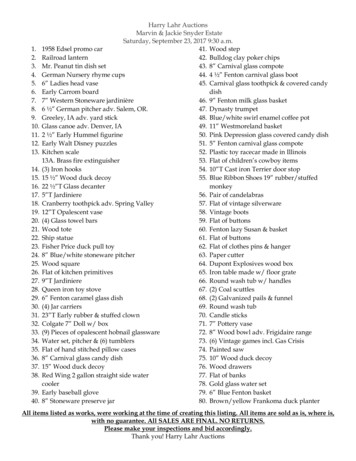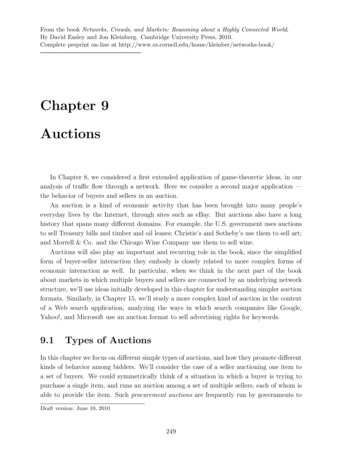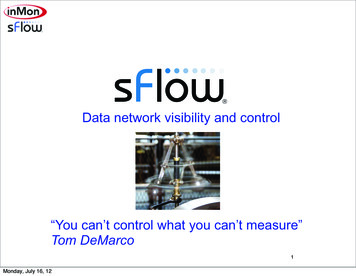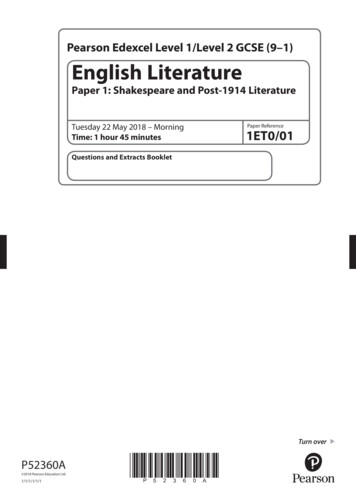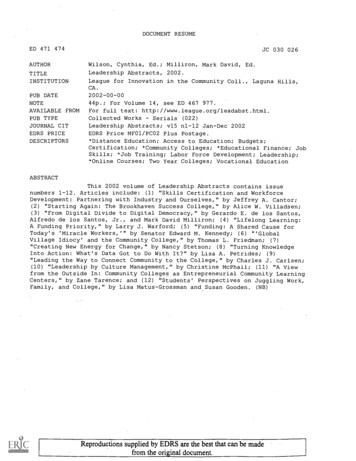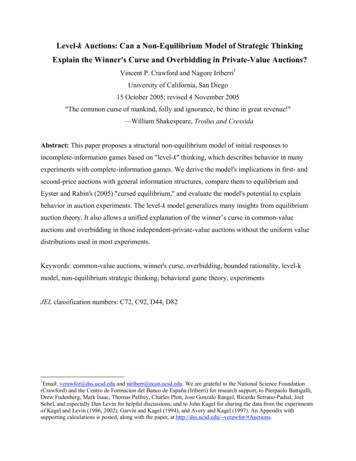
Transcription
Level-k Auctions: Can a Non-Equilibrium Model of Strategic ThinkingExplain the Winner's Curse and Overbidding in Private-Value Auctions?Vincent P. Crawford and Nagore Iriberri1University of California, San Diego15 October 2005; revised 4 November 2005"The common curse of mankind, folly and ignorance, be thine in great revenue!"—William Shakespeare, Troilus and CressidaAbstract: This paper proposes a structural non-equilibrium model of initial responses toincomplete-information games based on "level-k" thinking, which describes behavior in manyexperiments with complete-information games. We derive the model's implications in first- andsecond-price auctions with general information structures, compare them to equilibrium andEyster and Rabin's (2005) "cursed equilibrium," and evaluate the model's potential to explainbehavior in auction experiments. The level-k model generalizes many insights from equilibriumauction theory. It also allows a unified explanation of the winner’s curse in common-valueauctions and overbidding in those independent-private-value auctions without the uniform valuedistributions used in most experiments.Keywords: common-value auctions, winner's curse, overbidding, bounded rationality, level-kmodel, non-equilibrium strategic thinking, behavioral game theory, experimentsJEL classification numbers: C72, C92, D44, D821Email: vcrawfor@dss.ucsd.edu and niriberr@econ.ucsd.edu. We are grateful to the National Science Foundation(Crawford) and the Centro de Formacion del Banco de España (Iriberri) for research support; to Pierpaolo Battigalli,Drew Fudenberg, Mark Isaac, Thomas Palfrey, Charles Plott, Jose Gonzalo Rangel, Ricardo Serrano-Padial, JoelSobel, and especially Dan Levin for helpful discussions; and to John Kagel for sharing the data from the experimentsof Kagel and Levin (1986, 2002), Garvin and Kagel (1994), and Avery and Kagel (1997). An Appendix withsupporting calculations is posted, along with the paper, at http://dss.ucsd.edu/ vcrawfor/#Auctions.
1. IntroductionCommon-value auctions, in which the value of the object being sold is unknown but thesame to all bidders ex post and each bidder receives a private signal that is correlated with thevalue, have been studied intensively, both theoretically and empirically, since Milgrom andWeber (1982; "MW"); see the surveys by McAfee and McMillan (1987, Section X), Milgrom(1985, Section 4; 1987, Section 4), Wilson (1992, Section 4.2), and Klemperer (2000, Chapter 1).A central problem in this area is explaining the "winner's curse," the frequent tendency forwinning bidders in common-value auctions to find, on average, that they have bid more than theobject being sold is worth.2 The curse, as we shall call it, was first noted in oil-lease auctions bypetroleum engineers (Capen, Clapp, and Campbell (1971)) and studied theoretically by Wilson(1969). It has since been detected in many analyses of field data (Hendricks, Porter, and Boudreau(1987); Hendricks and Porter (1988); and the papers surveyed in McAfee and McMillan (1987,Section XII), Thaler (1988), Wilson (1992, Section 9.2), and Laffont (1997, Section 3)). Thecurse has also been observed in laboratory experiments with precise control of the informationconditions on which it depends (Bazerman and Samuelson (1983); Kagel and Levin (1986;"KL"); Dyer, Kagel, and Levin (1989); Lind and Plott (1991; "LP"); and the papers surveyed inKagel (1995, Section II) and KL (2002)). Finally, curse-like phenomena have been observed innon-auction settings that share the informational features of common-value auctions: bilateralnegotiations in the Acquiring a Company game in Samuelson and Bazerman (1985), Holt andSherman (1994; "HS"), Tor and Bazerman (2003), and Charness and Levin (2005); the MontyHall game in Friedman (1998), Tor and Bazerman (2003), and Palacios-Huerta (2003); zero-sumbetting with asymmetric information in Sovik (2000) and Sonsino, Erev, and Gilat (2002); andvoting and jury decisions in Fedderson and Pesendorfer (1996, 1997, 1998). There is also anexperimental literature on independent-private-value auctions, which documents a widespreadtendency for subjects to bid higher than in the risk-neutral Bayesian equilibrium—though notusually to the point of making losses as in common-value auctions; see Cox, Smith, and Walker(1983, 1988); Goeree, Holt, and Palfrey (2002; "GHP"); and the references cited there.The curse is often attributed informally to bidders' failure to adjust their value estimates forthe information revealed by winning. Such adjustments are illustrated by the symmetric Bayesianequilibrium of a first- or second-price auction with symmetric bidders, where bidders adjust their2This definition is the one most often used in the literature. We use the term "common-value" to include MW's (1982)general notion of interdependent values with affiliated signals as well as pure common values.1
expected values for the fact that the winner's private signal must have been more favorable thanall others' signals, and so overestimates the value based on all available information.3 But despitethe empirical importance of overbidding in independent-private-value auctions and curse-likephenomena in common-value auctions, there have been few attempts to model them formally.KL (1986) and HS (1994) formalize the intuition behind the curse in models in which"naïve" bidders do not adjust their value estimates for the information revealed by winning, butotherwise follow equilibrium logic. Eyster and Rabin's (2002, 2005; "ER") notion of "cursedequilibrium" generalizes KL’s and HS’s models to allow intermediate levels of value adjustment,ranging from standard equilibrium with full adjustment to "fully-cursed" equilibrium with noadjustment. ER also generalize KL’s and HS’s models from auctions and bilateral exchange toother kinds of incomplete-information games.4 All three models allow players to deviate fromequilibrium only to the extent that they do not draw correct inferences from the outcome. Thustheir predictions coincide with equilibrium in games in which such inferences are not relevant,and they do not help to explain non-equilibrium behavior in independent-private-value auctions.Other analyses, also assuming equilibrium, seek to explain overbidding in independentprivate-value auctions via various deviations from risk-neutral expected-monetary-payoffmaximization: risk aversion in Cox, Smith, and Walker (1983, 1988) and HS (2000); the "joy ofwinning" in Cox, Smith, and Walker (1992) and HS (1994); and both of these plus nonlinearprobability weighting, using McKelvey and Palfrey's (1995) notion of quantal responseequilibrium ("QRE"), in GHP (2002).5These explanations all assume the perfect coordination of beliefs about others' strategies thatis characteristic of equilibrium analysis. Such coordination is plausible when bidders have had3A bidder's bid should be chosen as if it were certain to win because it affects the bidder's payoff only when it wins.In Samuelson and Bazerman's (1985) experiments with the Acquiring a Company game, both less- and moreinformed subjects tend to choose as if their (more- or less-informed) partner's information was the same as their own.In Acquiring a Company, cursed equilibrium would assume this for a less-informed player but not a more-informedplayer. It is unclear how to extend Samuelson and Bazerman's interpretation to auctions in which each player hassome private information, so that no one is unambiguously less- or more-informed. Neither of the obvious choices—that a player ignores his own private information, or alternatively assumes that all others share it—seems sensible.5QRE is a generalization of equilibrium that allows players' choices to be noisy, with the probability of each choiceincreasing in its expected payoff, given the distribution of others' decisions; a QRE is thus a fixed point in the spaceof players' choice distributions. GHP (2002) use QRE to analyze the results of experiments with independent-privatevalue auctions. To our knowledge QRE has not been used to analyze common-value auctions. Risk aversion has beenapplied mainly to explain overbidding in independent-private-value auctions, with the notable exception of HS(2000). As LP (1991) note, common-value auctions with risk aversion are not well understood theoretically.42
ample opportunity to learn from experience with analogous auctions.6 But some auctions thathave been studied using field data lack enough clear precedents to make equilibrium a plausiblehypothesis for initial responses; and subjects may learn slowly in auction experiments, especiallywith common values (LP (1991); Ball, Bazerman, and Carroll (1991); Garvin and Kagel (1994);Kagel and Richard (2001); and Palacios-Huerta (2003)). The justification for equilibrium thendepends on strategic thinking rather than learning, but such thinking may not follow the fixedpoint logic of equilibrium. It may then be just as plausible to relax the assumption of equilibriumas to relax correct value adjustment or risk-neutral expected-money-payoff maximization.Progress via relaxing equilibrium depends on specifying a structural model that accuratelydescribes initial responses to games.7 In this paper we reconsider the winner's curse in commonvalue auctions and overbidding in independent-private-value auctions using a non-equilibriummodel of initial responses based on "level-k" thinking, introduced by Stahl and Wilson (1994,1995) and Nagel (1995) and developed and further applied by Ho, Camerer, and Weigelt (1998);Costa-Gomes, Crawford, and Broseta (2001); Crawford (2003); Camerer, Ho, and Chong (2004;"CHC"); Costa-Gomes and Crawford (2004); and Crawford and Iriberri (2005). The level-kmodel has strong experimental support, which should help to allay the common concern that onceone departs from equilibrium, "anything is possible." We focus on symmetric first- and secondprice auctions, leaving their progressive Dutch and English counterparts for future work.The level-k model has the potential to give a unified explanation of overbidding inindependent-private-value and common-value auctions as well as curse-like phenomena in othersettings. It also promises to establish a link between empirical auction studies and non-auctionexperiments on strategic thinking, and thereby to bring a large body of auction evidence to bear6Such experience might justify fully cursed equilibrium, for instance, by teaching bidders the tradeoff between thecost of higher bids and their increased probability of winning without also teaching them to avoid the curse. In thefield bidders seldom observe others' value estimates, which impedes learning about the curse. In most of the relevantexperiments, subjects' bids and signals were made public after each round, but even experienced subjects may focuson the relationship between the winner's signal and bid and the realized value of the object, without looking forrelationships like the curse. It seems much harder to justify less than fully-cursed equilibrium, because once onerealizes there may be a relationship to look for, there is no obvious reason to stop at intermediate levels of cursedness.7Maintaining common knowledge of rationality but otherwise leaving beliefs unrestricted yields notions likerationalizability, which implies some restrictions on behavior in first-price auctions or common-value second-priceauctions, and duplicates equilibrium in independent-private-value second-price auctions. k-level rationalizability—consistency with rationality and mutual certainty of (k-1)-level rationalizability—implies bounds on behavior in firstprice auctions characterized in Battigalli and Siniscalchi (2003) and restricts behavior in common-value second-priceauctions, and also duplicates equilibrium in independent-private-value second-price auctions. By contrast, ourapproach dispenses with common knowledge of rationality (and beliefs) but normally yields unique predictions.3
on the issue of how best to model initial responses to games. Finally, it allows us to explore therobustness of equilibrium auction theory’s conclusions to failures of the equilibrium assumption.The level-k model allows behavior to be heterogeneous, but it assumes that each player'sbehavior is drawn from a common distribution over a particular hierarchy of decision rules ortypes. Type Lk for k 0 anchors its beliefs in a nonstrategic L0 type and adjusts them via thoughtexperiments with iterated best responses: L1 best responds to L0, L2 to L1, etc. L1 and L2 haveaccurate models of the game and are rational; they depart from equilibrium only in basing theirbeliefs on simplified models of other players.8 This yields a workable model of others' decisionswhile avoiding much of the cognitive complexity of equilibrium analysis.9 In applications thepopulation type distribution is usually translated from previous work or estimated from thecurrent dataset. The estimated distribution tends to be stable across games, with most of theweight on L1 and L2. Thus the anchoring L0 type exists mainly in the minds of higher types.Even so, the specification of L0 is the key to the model's explanatory power and the mainissue that arises in extending the level-k model from complete- to incomplete-information games.We compare two specifications, both nonstrategic as is usual in level-k analyses. A random L0bids uniformly randomly over the feasible range, as in the complete-information level-k analysesof Stahl and Wilson (1994, 1995); Costa-Gomes, Crawford, and Broseta (2001); CHC (2004); andCosta-Gomes and Crawford (2004).10 A truthful L0 bids the value that its own private information8Charness and Levin (2005) conduct an interesting experimental test of "simplified models of others" explanations ofthe curse like the one proposed here, in an Acquiring a Company design with a "robot" treatment in which a singledecision-maker faces an updating problem that is cognitively the same as the one that underlies the curse. They findthat the curse persists in their treatment, and suggest that their results favor explanations based on limited cognition inBayesian updating or understanding the problem rather than simplified models of others. Their results suggest thatthe curse is due to some form of limited cognition rather than strategic uncertainty; but their analysis leaves open thepossibility that something like the level-k model accurately describes initial responses to environments, interactive ornot, that pose cognitive difficulties that are isomorphic to those of predicting other players' strategic decisions.9In Selten's (1998) words: "Basic concepts in game theory are often circular in the sense that they are based ondefinitions by implicit properties . Boundedly rational strategic reasoning seems to avoid circular concepts. Itdirectly results in a procedure by which a problem solution is found. Each step of the procedure is simple, even ifmany case distinctions by simple criteria may have to be made." Costa-Gomes and Crawford (2004) summarize theevidence for the level-k model and give support for our assumptions that L2 best responds to an L1 without decisionerrors, unlike in Stahl and Wilson (1994, 1995); and to L1 alone rather than a mixture of L1 and L0, unlike Worldly inStahl and Wilson (1995) and L2 in CHC (2004). We confine attention to L0, L1, and L2 because they well illustratethe model's potential to explain auction behavior and the evidence suggests that higher types are comparatively rare.10In the only other incomplete-information level-k model of which we are aware, CHC (2004, Section VI.A) use theirclosely related "cognitive hierarchy" model, with a random L0, to explain curse-like phenomena in Sonsino, Erev,and Gilat's (2002) and Sovik's (2000) experimental results on zero-sum betting with asymmetric information. Onecould easily imagine other possible specifications of random L0, for example restricting the range of variation to bidsthat can be rational, given one's own information. But bearing in mind that L0 is only the starting point for a player'sanalysis of others' behavior, simplicity is a virtue. Ultimately the "correct" specification is an empirical question.4
suggests, taken by itself. Although truthfulness has no natural meaning in most settings for whichlevel-k analyses have been conducted, in auctions it is both meaningful and plausible, given thatL0 is only the starting point for a strategic analysis.11 We call the L1 and L2 types based on arandom L0, random L1 and L2 types, with analogous terms for the truthful L1 and L2 types basedon a truthful L0. We stress that these L1 and L2 types need not be random or truthful themselves.Although a level-k model's predictions coincide with equilibrium in many simple games, ingames as complex as auctions they may deviate systematically from equilibrium. The deviationsare determined by the same two factors that determine an equilibrium bidder's bidding strategy—value adjustment for the information revealed by winning and the bidding trade-off between ahigher bid's cost and its increased probability of winning—but the influences of these factors arealtered by a level-k type's non-equilibrium beliefs. The pattern of L1’s and L2’s deviations acrossfirst- and second-price common- and independent-private-value auctions determines the extent towhich a level-k model with an empirically plausible type distribution allows a unified explanationof the systematic, heterogeneous deviations from equilibrium such auctions often evoke.Our analysis yields two main conclusions. First, many of the insights of equilibrium auctiontheory extend, suitably interpreted, to level-k auction theory.12 Second, a random level-k model(but not a truthful level-k model) can yield an empirically plausible explanation of both thewinner’s curse in common-value auctions and overbidding in those independent-private-valueauctions without the uniform value distributions used in most experiments.In common value auctions, because a random L0's bids are independent of its private signal,a random L1 completely ignores the information revealed by winning, just as ER's fully-cursedequilibrium bidders do. In a second-price auction the bidding trade-off is neutral and a randomL1's failure to adjust the value makes its bids coincide with a fully-cursed equilibrium bidder's, sothat it normally overbids relative to equilibrium. In a first-price auction a random L1 differs from11Our truthful L0 is equivalent to LP's (1991) "naive model" and our random L1 is close to their "private-value"model. Our truthful L0 is also reminiscent of the truthful sender type W0 in Crawford's (2003) level-k analysis ofstrategic deception via cheap talk, which also appears frequently in the informal literature on deception and receivessome support in communication experiments (Crawford (1998), Cai and Wang (2005), and the references citedthere). Models that adapt L0 to the setting in other ways include Ho, Camerer, and Weigelt's (1998) analysis ofguessing games, where L0 is random with an estimated central tendency; and Crawford and Iriberri's (2005) analysisof Hide-and-Seek games, where L0 responds to the non-neutral framing of locations. By contrast, the level-k model'sother main assumption, the adjustment of higher-level types' beliefs via iterated best responses, appears to allow asatisfactory account of initial responses to many different kinds of games.12To the extent that equilibrium insights do not generalize, it is mainly because level-k types, by best responding tolevel-(k-1) types, break the symmetry of a standard equilibrium analysis, which creates difficulties like those inequilibrium analyses of asymmetric auctions (McAfee and McMillan (1987, Section VII), Maskin and Riley (2000)).5
a fully-cursed-equilibrium bidder in using its non-equilibrium beliefs to evaluate a non-neutralbidding trade-off. In general a random L1 overbids relative to equilibrium but may either overbidor underbid relative to or coincide with fully-cursed equilibrium. In the leading example that hasbeen studied experimentally, KL's, a random L1 coincides with fully-cursed equilibrium withcommon values; and coincides with it and equilibrium with uniform, independent private values.Without uniformity, in general, a random L1 may underbid, overbid, or coincide with equilibrium.A random L1 coincides with equilibrium except for one possible valuation in one of GHP's (2002)independent-private-value treatments with discrete, slightly non-uniform values.In a second- or first-price auction, a random L1's bidding strategy is increasing in its signal,and so in common-value auctions a random L2 does adjust its value estimate for the informationrevealed by winning. Its value adjustment reflects the same logic as the second-price equilibriumbidding strategy, in that it bids according to the expected value given its own signal, conditionalon just winning; but its non-equilibrium beliefs do not anticipate winning if and only if it has thehighest signal, which leads to a different adjustment. In general, value adjustment tends to makebidders' bids strategic substitutes, because higher others' bids make a bidder believe that winningmeans others' signals are (stochastically) lower, which makes the curse seem worse and lowersthe expected value conditional on winning, and so tends to lower the bidder's optimal bid. In asecond-price auction, to the extent that a random L1 overbids relative to equilibrium, the strategicsubstitutability of value adjustment makes a random L2 underbid. This effect is also present in afirst-price auction, but there the bidding trade-off may either reinforce or work against thistendency to underbid. In KL's example the bidding trade-off works against it, and with commonvalues a random L2 coincides with equilibrium. With uniform, independent private values, arandom L2 coincides with equilibrium, like a random L1. With non-uniform independent privatevalues a random L2 may underbid, overbid, or coincide with equilibrium. In both of GHP's (2002)treatments, a random L2 tends to underbid.For empirically plausible type distributions, with L1 more frequent than L2, these patterns ofvariation in bidding behavior allow a random level-k model to fit experimental data for commonvalue auctions significantly better than equilibrium or cursed equilibrium; and to fit GHP's datafor non-uniform independent-private-value auctions significantly better than equilibrium and6
cursed equilibrium.13 A level-k model has additional advantages over cursed equilibrium, in that ituses more general strategic principles to give a structural account of subjects’ heterogeneousbidding behavior, with behavioral parameters linked to other bodies of evidence; and it has thepotential to explain non-equilibrium bidding in some other independent-private-value auctions.14The rest of the paper is organized as follows. In Section 2 we introduce MW's (1982)general model with interdependent values and affiliated signals and review the theories ofequilibrium and cursed-equilibrium bidding. In Section 3 we discuss the specification of a level-kmodel for auctions and derive its implications for random and truthful type hierarchies. In Section4 we compare equilibrium, cursed equilibrium, and the level-k model's implications with regard toexplaining the curse and overbidding in independent-private-value auctions. We start with the twoleading examples that were the basis of the auction experiments ER (2002, 2005) considered, thefirst-price auctions of KL (1986) and Garvin and Kagel (1994) and the second-price auctions ofAvery and Kagel (1997; "AK"). We also analyze second-price auctions in KL's example (forwhich ER (2002) but not ER (2005) discuss KL's results). Further, since independent-privatevalue auctions are especially useful for separating cursed equilibrium from level-k decision rules,we analyze GHP’s (2002) experimental design with discrete, slightly non-uniform values, inwhich level-k decision rules are separated from equilibrium. In Section 5 we reconsider theexperimental data in the light of Section 4's analysis, comparing the models' abilities to accountfor the individual initial responses of inexperienced subjects, which allow the cleanest tests of ourmodel, in settings like KL's, AK's, and GHP’s. Section 6 is the conclusion.2. Equilibrium and Cursed EquilibriumIn this section we review the theories of equilibrium and cursed-equilibrium bidding infirst- and second-price auctions. We use MW's (1982, Section 3) general model withinterdependent values and affiliated signals, which includes independent private values, purecommon values, and intermediate cases in which bidders observe affiliated private signals that areinformative about their interdependent values. Although ER's (2005) cursed equilibrium includes13In common-value auctions a truthful L1 tends to underbid relative to equilibrium or coincide with it in theexamples, which makes it difficult for a truthful level-k model to reconcile the data with a plausible type distribution.However, our estimates for GHP's treatments also include a small but significant fraction of truthful L1 subjects.14Cursed equilibrium, by contrast, can accommodate subjects' heterogeneous bidding behavior only by estimatingsubject-specific cursedness parameters as in ER (2005, Section 4).7
equilibrium as a special case, we begin with equilibrium and generalize to cursed equilibrium.Here and below, we assume risk-neutral, symmetric bidders and focus on symmetric equilibria.2a. Milgrom and Weber's general model with interdependent values and affiliated signalsMilgrom and Weber's general model with interdependent values and affiliated signals hasN bidders, indexed i 1, ,N, bidding for a single, indivisible object. Bidder i observes a privatesignal Xi that is informative about his value of the object, with X ( X 1 , X 2 ,., X N ) . The vectorS ( S1 , S 2 ,., S M ) includes additional random variables that may be informative about the valueof the object. In general, bidder i's value Vi u ( S , X ) , and the variables in S and X are affiliated(positively associated) as defined in MW (1982, Assumption 5 and Appendix). This generalmodel includes three leading special cases that are important in our analysis: the pureindependent-private-value model, in which M 0 and Vi u ( X i ) ; the pure common-value model(used in KL (1986) and LP (1991)), in which M 1 and Vi u (S ) ; and an alternative commonNvalue model (used in AK (1997)), in which Vi u ( X ) X n .n 1Because bidders are risk-neutral, if bidder i wins the auction and pays price p for theobject his payoff is Vi p . Without loss of generality, we focus on bidder 1 with value V1 andsignal X 1 . Let Y denote the highest estimate among other bidders' private signals X 2 , X 3 ,., X N . Yhas distribution function and density function, conditional on the realization, x, of X1, FY ( y x)and f Y ( y x) ; in cases where the signals are independent, we suppress the conditioning andwrite FY ( y ) and f Y ( y ) . It is also useful to define two expected value functions, which as functionsare the same for all i: the expected value conditional on winning v( x, y ) E[Vi X i x, Y y ] ,and the unconditional expected value r ( x) E[Vi X i x] .2b. Equilibrium in first- and second-price auctionsOur equilibrium analysis closely follows MW's analysis of their general affiliated-signalsand interdependent-values model; readers who are familiar with their analysis can skip ahead toSection 2.c's review of cursed equilibrium.In equilibrium, bidders correctly predict and best respond to the distribution of otherbidders' bids, taking into account the information to be revealed because in a symmetricequilibrium, the winner's estimate must be more favorable than others' estimates. In this8
subsection we assume other bidders use their equilibrium bidding strategies, a* ( x) in a first-priceor b* ( x ) in a second-price auction, which are both increasing, with inverses a* 1 (a) and b* 1 (b) .In a first-price auction, bidder i's optimal bidding strategy solves (for each x)(1)[a* 1 ( a )] (v( x, s) a ) fmax a E (Vi a )1{a* (Y ) a} X i x Y( s x)ds ,xwhere 1{·} is the indicator function. Taking the partial derivative with respect to a yields a firstorder differential equation that determines a as a function a(x) of x, which characterizes the firstprice equilibrium bidding strategy:15(2)a ' ( x) (v( x, x) a ( x) )f Y ( x x).FY ( x x)Solving (2) for the equilibrium bidding strategy a* ( x) and using the boundary conditiona* ( x ) v( x, x) to determine the constant of integration yields a general expression for the first-price equilibrium bidding strategy (MW (1982, p. 1107)):(3)x x f (t t ) dt d (v( s, s)).a* ( x) v( x, x) exp Yx s FY (t t ) a* ( x) reflects both the value adjustment for the information revealed by winning, via v( x, x) , andthe bidding trade-off, via the range of integration. The logic of value adjustment is that the biddershould bid according to the expected value given his own signal, conditional on just winning,which in equilibrium happens when his signal just exceeds the highest of the others' signals.With independent private values, v( x, x) x and the functions f Y ( y x) and FY ( y x) nolonger depend on x, so the interior integral on the right-hand side of (3) reduces toFY ( s )and theFY ( x)first-price equilibrium bidding strategy becomes:x(4)a* ( x ) x xFY ( s )ds E[Y Y X ].FY ( x)In a second-price auction, bidder i's optimal bidding strategy solves (for each x):15MW (1982, p. 1107-1108) show that the objective function in (1) is quasiconcave, so that the first-order conditionscharacterize the equilibrium strategies. MW's quasiconcavity argument breaks down for some of the optimizationproblems considered below, and level-k types' non-equilibriu
player. It is unclear how to extend Samuelson and Bazerman's interpretation to auctions in which each player has some private information, so that no one is unambiguously less- or more-informed. Neither of the obvious choices— that a player ignores his own private information, or alter
